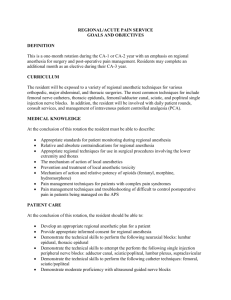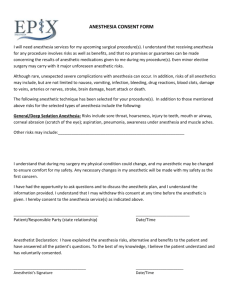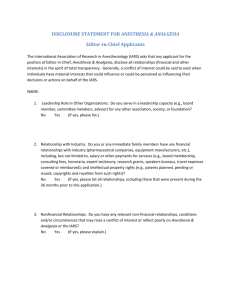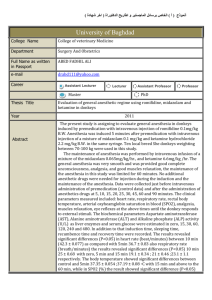Released EVDC Eq Exam Example Questions Anaesthesia
advertisement
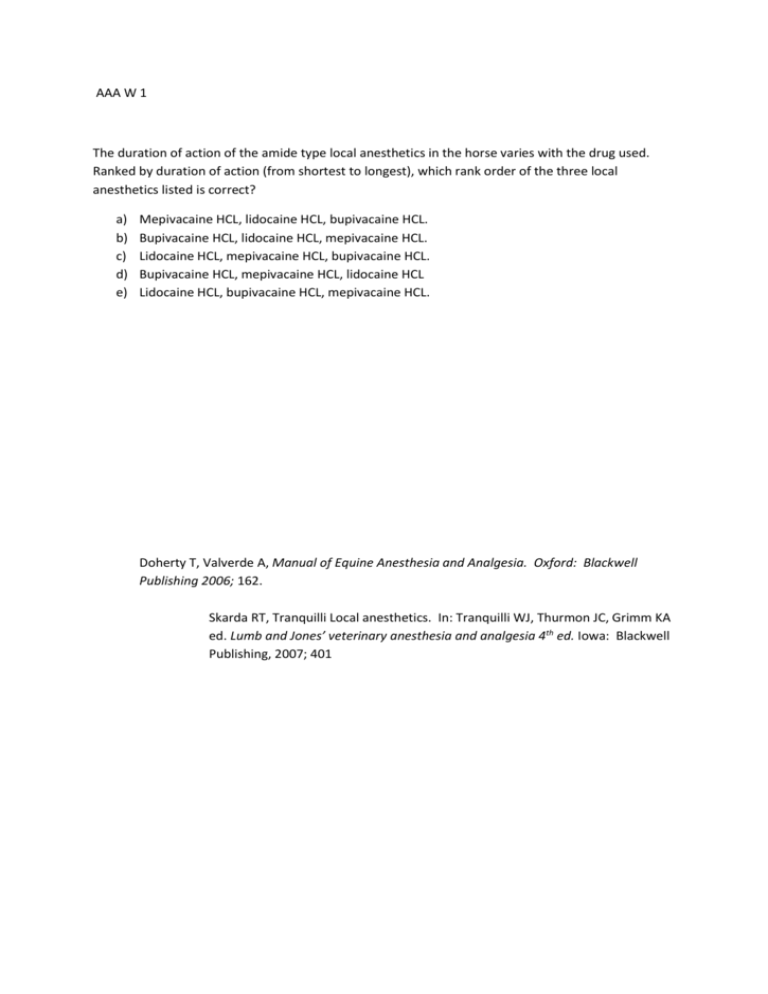
AAA W 1 The duration of action of the amide type local anesthetics in the horse varies with the drug used. Ranked by duration of action (from shortest to longest), which rank order of the three local anesthetics listed is correct? a) b) c) d) e) Mepivacaine HCL, lidocaine HCL, bupivacaine HCL. Bupivacaine HCL, lidocaine HCL, mepivacaine HCL. Lidocaine HCL, mepivacaine HCL, bupivacaine HCL. Bupivacaine HCL, mepivacaine HCL, lidocaine HCL Lidocaine HCL, bupivacaine HCL, mepivacaine HCL. Doherty T, Valverde A, Manual of Equine Anesthesia and Analgesia. Oxford: Blackwell Publishing 2006; 162. Skarda RT, Tranquilli Local anesthetics. In: Tranquilli WJ, Thurmon JC, Grimm KA ed. Lumb and Jones’ veterinary anesthesia and analgesia 4th ed. Iowa: Blackwell Publishing, 2007; 401 AAA W 2 When considering the differences in metabolism and responses to sedatives, anesthetics, and analgesics between horse and donkeys, which statement is MOST appropriate? a) Donkeys typically respond to sedatives (alpha2 agonists) and anesthetics (ketamine) in a manner similar to that of horses but often more frequent re-dosing compared to horses is warranted due to faster drug metabolism. b) In general donkeys eliminate drugs more slowly than do horses and thus require less frequent re-dosing of a drug. c) Generally for anesthetic drugs donkeys, like mules, require for the same effect a significantly higher dose compared to the horse. d) Differences in tissue distribution of anesthetic drugs in the horse vs. the donkey account for the donkey ‘s decreased sensitivity to anesthetic agents. e) Most donkeys and mules, being calm by nature, require less anesthetic drug per pound of body weight than horses. Doherty T, Valverde A, Manual of Equine Anesthesia and Analgesia. Oxford: Blackwell Publishing 2006; 234. MatthewsNS, Donkey Anesthesia and analgesia-not just small horses; Proceedings NAVC 2010, 208210. Matthews NS, Van Dijk P, Anesthesia and analgesia for Donkeys; IN Matthews NS, Taylor TS, Eds. Veterinary Care For Donkeys, Ithaca, International Veterinary Information Service 2004 PMD AAA B 157 In the above picture, sensory innervation to the region labeled 6 is provided by which nerve? a) Lacrimal b) Transverse facial c) Infraorbital d) Mandibular e) Lingual Tremaine, W. H. (2007), Local analgesic techniques for the equine head. Equine Veterinary Education, 19: 495–503. Doherty T and Schumacher J (2012) Dental restraint and anaesthesia. In: Equine Dentistry (3rd Edition) Editors Easley, KJ, Dixon, PM and Schumacher JS Elsevier Saunders AAB W 1 You are presented with an 8-year old pony with a body score of 3-4. He weighs about 310 pounds according to your weight tape. You performed a physical exam and find pulse and respiratory rate to be within normal limits and a temperature of 99.2F. You auscultate the heart and identify a grade lll/Vl outflow murmur. You elect to proceed with an oral exam and choose xylazine as your sedative. You draw up 200 mg of xylazine and intended to inject it into the jugular vein. Immediately the pony collapses to the ground and begins to thrash. The most likely cause of this response is: a) b) c) d) e) Cardiac arrest. Injection of xylazine into the carotid artery. Anaphylactoid reaction to xylazine. Anaphylactic reaction to xylazine. An overdose of xylazine. Doherty T, Valverde A, Manual of Equine Anesthesia and Analgesia. Oxford: Blackwell Publishing 2006; 316-317, 305-306. Hubbell JAE, Horses In: Tranquilli WJ, Thurmon JC, Grimm KA ed. Lumb and Jones’ veterinary anesthesia and analgesia 4th ed. Iowa: Blackwell Publishing, 2007; 720 DLF AAB B 165 A 7-year old gelding is anesthetized for repulsion of tooth. The surgical site is clipped and aseptically prepped in the image provided. A nerve block will be performed to provide multimodal anesthesia and post-operative pain control. Which regional nerve block is most appropriate for the planned procedure? a. b. c. d. e. Infraorbital nerve block Mental nerve block Local infusion of anesthetic solution at the site of the incision only Inferior alveolar nerve block Maxillary nerve block Doherty T, Schumacher J. Dental restraint and analgesia. In Equine Dentistry. New York: Saunders-Elsevier Limited, 2011; 242-244 AAC W 1 In the event of a respiratory arrest followed by cardiovascular collapse of an animal during a standing procedure, the cardiopulmonary resuscitation shall include all of the following EXCEPT: a) Immediate naso- or orotracheal intubation with an appropriately sized, preferentially cuffed, endotracheal tube that then will be attached to a demand valve coupled to an oxygen source for positive pressure ventilation 4-6 times per minute. b) Immediate IV infusion of crystalloid fluids to support the circulation. c) Immediate termination of any constant rate infusion of sedative and/or analgesic/anesthetic drugs. d) Immediate IV administration of a respiratory stimulant such as doxapram. e) Administration of IV epinephrine (3-5 μg/kg) in the event of cardiac arrest. Hubbell JAE, Horses. In: Tranquilli WJ, Thurmon JC, Grimm KA ed. Lumb and Jones’ veterinary anesthesia and analgesia 4th ed. Iowa: Blackwell Publishing, 2007; 718 Muir WW, Hubbell JAE. In: Equine Anesthesia 2nd ed., Phialdelphia: Saunders Elsevier. 2009; 418ff. AAC B 1 The nerve block indicated in the image is used to regionally block tooth 304 for extraction. Which statement is most accurate regarding this procedure? a. Never sedate the horse prior to administering the block because once sedated the effectiveness of the nerve block cannot be evaluated. b. Use a 3” spinal needle that is passed into the nerve canal to its hub. This will assure deposition of the anesthetic at the proper site. c. Use at least 15 mL of anesthetic, slowly injected into the foramen to assure adequate exposure of the nerve to the local anesthetic agent. d. If a long procedure is expected (in excess of 1 hour), increase the volume of the local anesthetic agent so it will last longer. e. Introduce the needle roughly 1 cm rostral to the foramen at a 30-40 degree angle to the bone. Advance the needle ~1cm into the foramen and apply light digital pressure at the mental foramen to prevent outflow of the anesthetic solution during deposition. Rawlinson JE Regional nerve blocks for dental extraction in Proceedings, ACVS 2012 516-519


